|
This article is about the university in Ottawa, Ontario, Canada. For Carleton College in Northfield, Minnesota, US, see Carleton College.
Coordinates: 45°22′59″N 75°41′51″W / 45.3831°N 75.6976°W / 45.3831; -75.6976
| Carleton University |
 |
| 校训 |
"Ours the Task Eternal" |
| 建立于 |
1942 |
| 类型 |
Public |
| Religious affiliation |
non-denominational |
| 捐赠 |
C$230 million |
| Chancellor |
Rt. Hon. Herb Gray |
| 校长 |
Dr Roseann Runte |
| 工作人员 |
4,260 |
| 学生 |
25,262 |
| 本科生 |
21,732 |
| 研究生 |
3,531 |
| 位置 |
 Ottawa, Ontario, Canada Ottawa, Ontario, Canada |
| 校园 |
Urban (0.62 km) |
| Sport Teams |
Carleton Ravens |
| Colours |
|
| 昵称 |
Ravens |
| Mascot |
Rodney the Raven |
| 归属 |
ASAIHL, APSIA, AUCC, CARL, IAU, COU, ACU, CIS, OUA, Fields Institute, Ontario Network of Women in engineering, CBIE |
| 网址 |
www.carleton.ca |
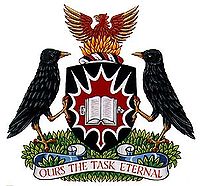
|
Carleton University is a comprehensive university located in Canada's capital of Ottawa, Ontario. The enabling legislation is the The Carleton University Act, 1952, S.O. 1952. Founded as a small college in 1942, Carleton now offers over 65 programs in a diverse range of disciplines, including public affairs, journalism, film studies, engineering, high technology, and international studies. More than 2000 faculty members instruct some 23,000 students drawn from over 147 countries, studying for a Bachelor's, Master's or Doctoral degree. The University is named after Carleton County, Ontario, which included the city of Ottawa at the time Carleton was founded. Carleton County, in turn, was named in honour of Guy Carleton, 1st Baron Dorchester, an early Governor-General of British North America.
Past chancellors include two Nobel laureates; pioneering scientist Gerhard Herzberg and Prime Minister Lester B. Pearson, as well as six Order of Canada recipients. The Right Honourable Herb Gray, Canada's longest-serving continuous Member of Parliament, former Cabinet minister in the Trudeau, Turner, and Chretien governments, former Deputy Prime Minister, and acting Leader of the Opposition, is the current Chancellor of the University. Dr. Roseann Runte was appointed the university's president on January 8, 2008, succeeding David W. Atkinson and his pro tempore (acting) successor Samy Mahmoud, the previous Vice-President (academic).
历史
I learned very early the life lesson that it is people, not buildings, that make up an institution. And if we put our hearts to it we can do something worthwhile. -- Henry Marshall Tory
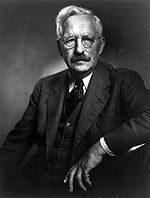
Henry Marshall Tory, first President of Carleton College
Carleton College, a non-denominational college was founded in 1942 at the height of the Second World War by the Ottawa Association for the Advancement of Learning. It was originally located in a rented building and only offered night courses in public administration and introductory university subjects. When the war ended in 1945, the College began expanding to meet the needs of veterans coming home. The Faculty of Arts and Science was established, which included courses in journalism and first-year engineering.
In 1946 the college moved to The Glebe neighbourhood along First Avenue at the former Ottawa Ladies' College. Its first degrees were conferred in 1946 to graduates of its programs in Journalism and Public Administration.
For nearly a decade the College operated on a shoestring budget, funds raised mainly through community initiatives and modest student fees. However, due to the war, student fees were kept low as Carleton gave special grants to veterans returning home who wished to continue their studies. The faculty was composed largely of part-time professors who worked full-time in the Public Service; some of whom were convinced to leave for full-time tenure positions. However, full-time teaching staff were still mostly young scholars at the beginning of their careers.

Leslie Frost, Premier of Ontario, laying the cornerstone of the Tory Building in 1957
In 1952 the Carleton College Act was passed by the Ontario Legislature, changing the official corporate name to Carleton College and officially conferring the power to grant degrees. Carleton thus became the province's first private, non-sectarian college. In the same year, the 62 hectare property nestled between the Rideau Canal and the Rideau River on which the current campus is located was acquired. Some of the land was donated by a prominent Ottawa businessman Harry Stevenson Southam. Construction began on the new campus in 1953.
Carleton was granted a university charter in 1957. In 1957 the Carleton University Act, 1952 was amended, officially granting Carleton status as a university and thus changing its name to Carleton University. Carleton's motto, "Ours the Task Eternal," is taken from Walt Whitman's poem, Pioneers! O Pioneers!.
The governance was modelled on the provincial University of Toronto Act of 1906 which established a bicameral system of university government consisting of a senate (faculty), responsible for academic policy, and a board of governors (citizens) exercising exclusive control over financial policy and having formal authority in all other matters. The president, appointed by the board, was to provide a link between the 2 bodies and to perform institutional leadership.
In 1959 construction was completed on the new Rideau River campus, and Carleton moved to its current location. The original buildings included three that still stand today, the Maxwell MacOdrum Library, Norman Paterson Hall and the Henry Marshall Tory Building. Following this, Carleton rapidly expanded to meet the need for tertiary education in Canada.
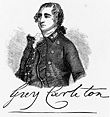
A portrait of Guy Carleton
The policy of university education initiated in the 1960s responded to population pressure and the belief that higher education was a key to social justice and economic productivity for individuals and for society.
In 1967 the Catholic school Saint Patrick's College was incorporated into Carleton. Up to that time, St Pat's had been granting its diplomas via the University of Ottawa. Both schools had been inaugurated by the Catholic order Oblates of Immaculate Mary ( OMI ). The college existed on Echo drive, near the Pretoria bridge. Around 1973 a new building was erected on the Carleton campus proper for St Pat's. The college was dissolved as a separate entity after the 1979 academic year. Its final dean was Gerald Clarke who had been a professor at St Pat's from 1954. St Pat's had been known for its school of Social Work.
Carleton University launched its program in architecture in 1968.
学术
Faculty of Public Affairs
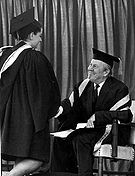
Lester B. Pearson, Carleton's Nobel Peace Prize winning Chancellor from 1969 until his death in 1972
The University's Faculty of Public Affairs offers a number programs. Indeed, Carleton's first degrees were awarded in Journalism and Public Administration. Carleton's Norman Paterson School of International Affairs (NPSIA) offers Canada's only graduate programs in the field —an MA, a combined MA and LLB (offered in conjunction with the University of Ottawa Law School), and a PhD in International Affairs. In a survey of 110 Canadian foreign affairs scholars published in Foreign Policy, Carleton's Norman Paterson School of International Affairs ranked 1st in Canada and 2nd in North America in schools offering Masters degrees in International Relations. Carleton has a long standing tradition of conferring an honorary doctorate on each of the Secretaries General of the United Nations, beginning with Dag Hammarskjöld in 1954. The two shades of blue in Carleton's doctoral gown are in fact those of the UN and are meant to recognize the University's long-standing interest and expertise in international affairs. Carleton's unique Arthur Kroeger College of Public Affairs offers the honours Bachelor of Public Affairs and Policy Management degree. It offers a BA (Honours) in European and Russian Studies and an MA in European, Russian and Eurasian Studies. In September 2006 Carleton was designated a European Union Centre of Excellence by the European Commission in Brussels. The Department of Law offers a BA (Honours) in Law; one of only three in Canada that takes an epistemic approach to legal studies. The Department of Political Science was ranked 1st in 2006 amongst Canadian comprehensive universities based on total publications and citations by Research Infosource Inc. Additionally, they have been noted as having a strong Department of Social Work, which grants Honours and Master's level degrees.
Faculty of Arts and Social Sciences
The Faculty of Arts and Social Sciences offers degrees in all the standard areas, including Film Studies, Philosophy, Art History, Psychology and Sociology. Some of the more specialized offerings include a Combined BA (Honours) interdisciplinary degree in Human Rights. This degree leads to a Major in Human Rights, as well as second Major in another field, such as Law, Philosophy, Political Science or Sociology and Anthropology. The Bachelor of Humanities (Honours) program is also Canada's most comprehensive four-year Liberal Arts degree in the Great Books. Carleton's Institute of Cognitive Science is currently offering the first dedicated, fully structured BA and PhD program in Cognitive Science in the country.
Sprott School of Business
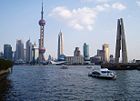
BIB year abroad in Shanghai
The Sprott School of Business was the first in Canada to offer a Bachelor of International Business (BIB). This program includes a mandatory language component and the third year is spent abroad. Possible year-abroad locations include Argentina, Austria, Belgium, Chile, China, France, Germany, Japan, Mexico, Peru or Spain. Sprott's principle undergraduate offering, however, is the 4-year Bachelor of Commerce (Honours) degree. It is designed to be flexible, allowing a variety of concentrations and opportunities for Co-operative education (Co-op). It offers students the choice to specialize in either one or two concentrations through a range of subjects (e.g.: Accounting, Finance, Information Systems, International Business, Human Resource Management, Marketing, Operations Management). Students also have the opportunity to study abroad in conjunction with their Honours Bachelor of Commerce degree Exchange Partners. Sprott has two MBA programs: In addition to the standard Canadian-taught MBA are two international MBA programs designed for international students. This special program are offered to students in Tehran, Iran and Shanghai, China in collaboration with a local university. Most courses are taught by Carleton professors who travel to Tehran and Shanghai. There is a study abroad portion of this program, which is taught in Ottawa at the Sprott School of Business.
Faculty of Engineering and Design
The Faculty of Engineering and Design includes four departments: Systems and Computer Engineering, Mechanical and Aerospace Engineering, Civil and Environmental Engineering and Electronics, and three schools of architecture and industrial design. Students can choose to specialize in the following disciplines:
- Architecture
- Aerospace Engineering**
- Biomedical and Electrical Engineering
- Biomedical and Mechanical Engineering
- Civil Engineering**
- Communications Engineering**
- Computer Systems Engineering**
- Electrical Engineering**
- Engineering Physics**
- Environmental Engineering**
- Mechanical Engineering**
- Software Engineering**
- Sustainable and Renewable Energy Engineering
- Bachelor's of Information Technology: Interactive Multimedia and Design
- Bachelor's of Information Technology: Networking Technologies [2]
Note: ** fully accredited degrees, the other engineering programs are recently begun and currently
going through the accreditation process with Professional Engineers of Ontario.
Carleton's bachelor of engineering in aerospace was the first in Canada and its Industrial Design program is among one of the oldest in Canada. Carleton is still one of only two fully dedicated Aerospace Engineering Bachelor's degree programs in Canada. The program avails itself of an extensive network of well-equipped laboratories encompassing the entire scope of mechanical and aerospace engineering sciences, including rapid prototyping facilities and a fully operational wind tunnel. In 2006, Carleton became one of only three Universities in Canada to offer both a Bachelor's (Honours) and a Master's degree in Biomedical Engineering. The Department of Civil and Environmental Engineering features a state-of-the-art structures lab, a High Performance Computing Laboratory and is home to the Advanced Geotechnical Research Laboratory, which is one of the most comprehensively equipped geotechnical research facilities in Canada. The Department of Electronics features an Anechoic chamber, Photonics Research Laboratory, NeuroModeler Laboratory, Sun/Unix Network and an Integrated Circuit Fabrication Laboratory housed in an ISO 5 cleanroom.
Faculty of Science
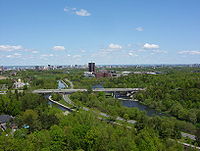
Carleton University campus as seen from the south.
The Department of Biology is equipped to allow students to carry out contemporary procedures in experimental biology including all aspects of molecular genetics such as gene splicing, polymerase chain reaction, and DNA sequencing; ultracentrifugation; various types of electrophoresis, tissue culture; phase contrast, polarizing, interference and fluorescent light microscopy among others.
The Department of Earth Science maintains its own Camebax MBX electron microprobe, ThermoFinnigan Triton TI thermal ionization mass spectrometer and a Philips X-ray powder diffractometer.
The Department of Physics is home to the KEG research computing system, which consists of a 100+ CPU Linux cluster complete with multiple storage arrays totalling more than 10 Terabytes. The Department of Physics was also ranked 1st in Canada in citations per paper (highest impact) from 2000-2004 by Science Watch newsletter, published by Thomson Scientific, which uses university science indicators to examine the research of 46 Canadian universities in 21 different scientific fields. The Herzberg Laboratories building is equipped with roof-top observatory housing a 14 inch reflecting Celestron telescope which is used in first-year Astronomy courses.
The Department of Chemistry is located in the Steacie Building and its primary teaching lab recently underwent a major renovation, winning special mention in R&D Magazine's worldwide Lab of the Year architectural design competition for 2009. This world-class teaching facility, dubbed "The Superlab", is home to general chemistry, organic chemistry, and environmental chemistry labs. The Department of Chemistry is home to a Bruker Avance III 300 MHz and a recently upgraded Bruker AMX 400 MHz nuclear magnetic resonance spectrometer. The Steacie Building also houses the Faculty's scanning electron microscope facility, including Tescan Vega-II and Jeol JSM-6400 instruments. The Department of Chemistry is also home to many high performance liquid chromatographs, gas chromatographs, mass spectrometers, microwave reactors, ultraviolet, visible, infrared and Raman spectrometers.
The mineral Carletonite is named after the university.
Faculty of Graduate Studies and Research
 |
This section requires expansion. |
Book publishing
Carleton University Press, which was founded in 1982, focused on Canada's history, society and institutions. Carleton University Press is now managed by McGill-Queen's University Press. All titles published by Carleton University Press can be ordered through McGill-Queen's University Press.
Centres
High Performance Computing Consortium (HPCVL)
- The HPCVL mission is to provide supercomputer power to a number of universities in Eastern Ontario: Queen's University, Royal Military College of Canada, the University of Ottawa and Carleton University. Researchers are provided with the computational power needed to solve increasingly complex problems.
Educational Development Centre (EDC)
The Educational Development Centre is dedicated to the support of teaching excellence at Carleton University.
Located in 410 Dunton Tower, the Centre was established in 2002 with the amalgamation of Carleton University TV] (previously iTV) and the Teaching and Learning Resource Centre (TLRC). Two years later, the Centre's activities expanded with the addition of Instructional Media Services (IMS).
The EDC provides technological and pedagogical teaching tools and resources to faculty, instructors and Teaching Assistants.
Carleton's campus was the subject of art exhibit conceived by local artist Adrian Gröllner. The MODERN U. project sought to highlight the late modernist architecture exemplified by many of Carleton's early buildings.
Reputation
The mean admission grade for 2006 undergraduate entry was 81.7% or an A- in high school studies. Carleton has been included in a number of Canadian and international college and university rankings. Such studies must necessarily make subjective judgements as to criteria and methodology. As such they should be read with a certain level of statistical literacy:
- Carleton Ranked 7th out of out 11 schools in Macleans annual university rankings in the comprehensive category in 2008 for the 2nd year in a row.[3]
- In the 2007 Academic Ranking of World Universities published by The Institute of Higher Education of Shanghai Jiao Tong University, Carleton placed in the fourth quintile category (305th–401st overall) of the top 500 universities of the world. Seventeen Canadian universities ranked higher than 305.
- In the THES - QS World University Rankings of the top 500 universities in the world for 2008, Carleton University placed 346th, and 19th among Canadian universities.
- Carleton was among 15 Canadian schools ranked in the top 200 Economics programs worldwide, according to research output, as reported in a study by Kalaitzidakis et al.
- The University is one of 3 in Canada that offers a specialization in Financial Economics.
- In the tenth edition of the Gourman Report (1998), compiled by Dr Jack Gourman of the Princeton Review, ranked Carleton University 7th out of 60 universities in Canada.
- Carleton University's Department of Physics is ranked 1st in Canada in citations per paper (highest impact) from 2000-2004 by Science Watch newsletter, published by Thomson Scientific, which uses university science indicators to examine the research of 46 Canadian universities in 21 different scientific fields.
- The Department of Political Science is ranked 1st amongst Canadian comprehensive universities based on total publications and citations by Research Infosource Inc.
- In a survey of 110 Canadian foreign affairs scholars published in Foreign Policy, Carleton's Norman Paterson School of International Affairs ranked 1st in Canada and 2nd in North America in schools offering Masters degrees in International Relations, tieing with Georgetown University.
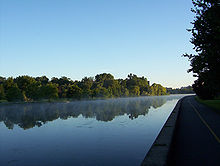
The Rideau Canal in front of Carleton University, at dawn
Carleton was historically known for admitting a high portion of undergraduate applicants, earning it the derogatory moniker of "Last Chance U"; however, since the early 1990s the admissions focus has changed considerably. William Edwin Beckel, President and Vice-Chancellor of Carleton from 1979 to 1989, had faith that many high school students with poor academic records, who often came from underprivileged backgrounds, would blossom at university. Beckel believed that "Every student should have the right to fail." Today, the mean undergraduate admissions average is just under 82%, or an A- in High School studies.
Many undergraduates find it difficult to retain their scholarship, adding to their financial burden. Only 18 percent of Carleton students retain their scholarship which has prompted Carleton's administration to consider lowering the CGPA necessary to maintain an award from year to year, although this is common among other universities. At Carleton, a CGPA of 10 out of 12 points (equivalent to an A-), is necessary to maintain a scholarship.
Carleton has also turned around its financial situation, resulting in many improvements on campus. These include, inter alia, the $30 million construction of new athletics facilities and the $22 million, 9,011 m (97,000 ft) Human Computer Interaction (HCI) Institute Facility and Centre for Advanced Studies in Visualization and Simulation (V-SIM). More well-known, perhaps, is the $17 million upgrade and expansion to the University Centre. More recently a green globe designed residence was added named Frontenac House.
Libraries
|
|
It has been suggested that this section be split into a new article. (Discuss) |
Carleton is home to a number of specialty libraries, in addition to the three-million volume MacOdrum Library.
Maxwell MacOdrum Library
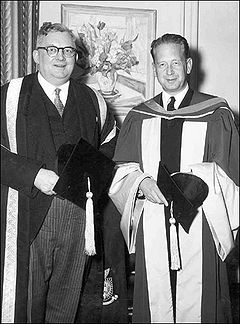
Carleton President and Vice-Chancellor Murdoch Maxwell MacOdrum, left, with Dag Hammarskjöld, Secretary-General of the United Nations and Nobel Laureate
Named in honour of former Carleton President and Vice-Chancellor Murdoch Maxwell MacOdrum, Carleton's collection includes more than three million books, journals, government documents, maps, newspapers, music scores, CDs, microforms, archives and rare materials.
The Learning Commons provides students with access to all the research facilities and resource support of the main Library, along with contemporary technology. Services include Wireless networking (University intranet and high-speed internet), 160 networked computers, laser printers, photocopy machines and Laptop Loans.
The Government Documents Collection contains official publications from all levels of government and international organizations in print, microform and digital formats.
The Geographic Information Systems (GIS) Collection contains orthophotos, airphotos and satellite images, digital elevation models (DEMs); topographic, street and boundary layers; thematic layers for Ottawa and the NCC; as well as geospatial data for geology, building heights, and Carleton University campus.
The Map Collection consists of topographic and thematic sheet maps, and air photos.
The Data Centre collects microdata and public opinion surveys, including those from Statistics Canada, Gallup, POLLARA and the Interuniversity Consortium for Political and Social Research.
The Special Collections & Archives is responsible for the Library's Special Collections, the Carleton University Historical Collection and the Library's own Archives.
Notable possessions include:
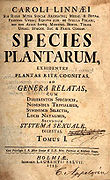
Species plantarum, first edition
- Paradise lost: a poem, in twelve books. London: Printed for C. Hitch and L. Hawes...[et al.], 1757
- Paradise regain'd: a poem in four books: to which is added Samson agonistes; :and Poems upon several occasions. London: Printed for J. and R. Tonson...[et al.], 1753
- The Faerie Queen; with a glossary, explaining the old and obscure words. London: Printed for J. and R. Tonson, 175:There is also a rare 1609 edition of The Faerie Queen in the collection
- 800 contemporary pamphlets of the French Revolution and Moniteur universal, le Journal officiel de la République français.
- A collection of 52 titles, chiefly on natural science and botany, almost half being published from the 16th to the 18th centuries. inter alia, titles by Adanson, Aldrovandi, Dalechamps, Ray, Lindley, Gesner, Gray, and Traill. Many are first editions, some in original bindings, illustrated with woodcuts and engravings. A highlight is a first edition of Linnaeus' Species plantarum.
- The Batchinsky collection, an extensive collection of over half a million items dealing with 19th- and 20th-century Ukrainian history and politics up to World War II.
- The Novosti Collection, a collection of 70,000 photographs, briefing notes, speech drafts, press releases, newspaper clippings and some pamphlets which was acquired from the former Soviet press agency Novosti in Ottawa. The collection covers the Soviet Union and Soviet society from 1917 to 1991 and USSR–Canada relations since World War II.
Audio Visual Resource Centre
Located on the fourth level of St. Patrick's Building, this Centre serves the School for Studies in Art and Culture. This includes Art History, Film Studies, Music and Sonic Design.
The Centre houses a large collection of films (16 mm, DVD, Laserdisc and VHS); a Slide and CD Collection Room; an Audiovisual Study Room and Computer Lab; course reserves, and staff that can provide students with specialized research assistance. There are also two photocopy machines available to students, along with some basic office supplies.
European and Russian Studies Resource Centre
The EURUS Centre houses a large collection of European, Russian and Eurasian-centred material that support the work of the Department. It is located on the 13th level of Dunton Tower. Collections include:
- Course reserves
- International newspapers
- Theses and master's research projects
- Honours research projects and essays
- About 325 periodicals, both general interest and specialist
- inter alia: Business Central Europe, Canada-Ukraine Monitor, Canadian Slavonic papers, CIS Environmental Watch, Croatian International Relations Review, Economics of Transition, Environmental Policy Review, Foreign Policy, Foreign Affairs, Human Rights Quarterly, Interflo, International Affairs, Kommersant, New Hungarian Quarterly, RFE (several series), The Economist, Ukrainian Quarterly, NATO Weekly Press Review
- Several hundred "pamphlets" (working papers, occasional papers, government documents, NGO publications, et cætera.)
- inter alia: Canadian Immigration and Refugee Board Documentation Centre, CSIS, CSCE, Council of Europe Parliamentary Assembly, EBRD, Hungarian Academy of Science, Institute of Finance Warsaw, IMF, Catholic University of Leuven, International Institute of Applied Systems Analysis, OECD, Osteuropa-Institutet, Hoover Institute Stanford University, UNCTAD, UN Institute for Disarmament Research, US National Defence College, Vienna Institute for Comparative Economic Studies, and WIDER
Student life
|
|
It has been suggested that this section be split into a new article. (Discuss) |
Culture
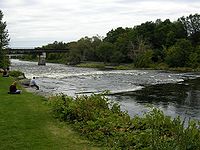
Rideau River as seen from Carleton University
The atmosphere at Carleton is generally quite relaxed and easy-going. In a sense typically Canadian, both students and instructors go about their business with a notable lack of pretension. Interaction between students and instructors is usually informal, though when addressing an instructor, academic titles are still commonly used.
The school mascot is the Raven and the student newspaper is The Charlatan, which celebrated its 60th anniversary in 2005. CUSA, the Carleton University Students' Association puts on programming for students every year including Pandamonium, which was started in 2006 by then President, Shawn Menard. The school also publishes a newspaper for residence students, The Resin. During the school year the Carleton School of Journalism publishes a community newspaper, Centretown News, which reports on the Centretown neighbourhood of Ottawa, and an online newspaper, Capital News Online, as well as producing Midweek, a 90-minute current affairs radio show which is broadcast to the city. There is also the student-run writers' zine, In/Words, which is sponsored by the Department of English Language and Literature, as well as The Iron Times, published by the Carleton Student Engineering Society. Carleton is home to a community radio station, CKCU-FM. Broadcasting for the first time on 14 November 1975, CKCU-FM was the first licensed community-based campus radio station in Canada. While Carleton does not have a theatre department, its Sock 'n' Buskin Theatre Company was founded two years after the founding of the university, in 1943.
Fraternities and sororities
Carleton is home to a number of fraternities and sororities, both local and international. The Greek life at Carleton is a generally understated affair. There is no "Greek row" on campus, nor are the fraternities/sororities formally acknowledged by the university. However, the Carleton University Greek Council (of which nearly all fraternities and sororities are members) is recognized as a student organization by CUSA. Fraternities and sororities are active on campus, participating in fund raising events, campus clean ups, days of service and more. As well, many fraternity and sorority members hold high positions on CUSA, CASG, RRRA and other campus organizations, controlling many of the schools social events.
Fraternities
- Acacia Fraternity
- Alpha Epsilon Pi
- Beta Theta Pi
- Kappa Sigma
- Sigma Pi
- Tau Kappa Epsilon
- Omega Psi Phi
Sororities
- Alpha Omicron Pi
- Alpha Pi Phi
- Delta Psi Delta
- Nu Sigma Pi
- Xi Delta Theta
- Tau Sigma Phi
- Phi Sigma Sigma
Student accommodations
Carleton has ten Houses of Residences. The Houses—all named for counties in Eastern Ontario -- are Dundas, Frontenac, Glengarry, Grenville, Lanark, Leeds, Prescott, Renfrew, Russell, and Stormont. They are inter-connected and linked to the rest of the University by Carleton's tunnel system. Carleton has a sizable residence community, the majority of whom are first year students (Except for those in Leeds House and Frontenac House; Leeds is usually reserved for upperclassmen/women and international students). The Frontenac house which opened on the 1st of September 2008, also hosts 2nd year (returning) students only. They are represented by the Rideau River Residence Association(RRRA, usually pronounced 'raw'). On-campus graduate students, who are housed on the upper two floors of Leeds House, are represented by the Graduate Residents' Association (GSA).
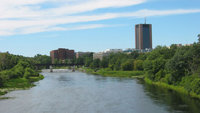
Carleton University as seen from the Rideau River
The bulk of upper-year students, however, live off-campus. A popular off-campus housing estate is the four-building high-rise Prince of Wales Complex on nearby Prince of Wales Drive. The footpath running along the Rideau Canal can usually be seen crowded with students walking the 2 km to Carleton.
Going east of the school gives students the option of renting a (usually) vintage house in The Glebe, one of the city's trendier neighbourhoods. From there it is usually only a short walk to campus. Though further afield, students also often rent in Centretown and downtown neighbourhoods.
Carleton is connected to the rest of the city by multiple transport links. In addition to regular bus service, there is a dedicated light rail station connecting the University to Ottawa's O-Train network. A permanent BlueLine taxi-cab stand is also available outside the University Commons building.
体育运动
The Carleton University Physical Recreation Centre (PRC), the largest facility of its kind in Canada, is a multi-use complex that offers a wide variety of training programs and services to accommodate every athlete—from beginner to professional.
Carleton is home to Keith Harris Stadium where the Ottawa Fury Soccer team plays.
The University is represented in Canadian Interuniversity Sport by the Carleton Ravens. The men's basketball team has won the CIS championships for five consecutive years (2002–2007). Carleton is second only to the University of Victoria for the most wins. The Vikes have seven consecutive wins in the 1980s.
Notable among a number of songs commonly played and sung at various events such as commencement, convocation and athletic games are: "On the steps of Carleton" the Carleton University fight song.
[edit] Rivalry with the University of Ottawa
|
|
It has been suggested that this section be split into a new article. (Discuss) |
Since Carleton's inception the student body has encouraged a crosstown rivalry with the University of Ottawa. The rivalry has gained ground recently as the Carleton Ravens basketball team was defeated for only the second time in three years during league play by the University of Ottawa Gee-Gees on 17 January 2006.
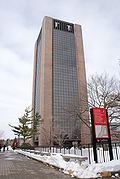
Dunton Tower, the tallest structure on campus
When Carleton University had a football team, the annual Ravens-Gee Gees match was held in Frank Clair Stadium at Lansdowne Park. This was known as the "Panda Game." Notably, Canadian comic and former Ottawa resident Norm Macdonald attended the Panda Game and discussed his experience on the Late Show with David Letterman. Audio recordings of this are perennially circulated and played to incoming freshman at both the University of Ottawa and Carleton.
University traditions
- Climbing to the top of Dunton Tower
One of the campus traditions is to climb all 22 flights of stairs to the top of the tallest building on campus. The Tower, (or The Arts Tower as it was once known) is also known by some as "Isengard" due to its size and the fact that many TAs have their offices in it.
Carleton Underground
The tunnel system
The entire University is connected by an elaborate five kilometre network of heated underground tunnels adorned with murals created by student groups. Students are encouraged, within reason, to create their own works of art. Each floor of the ten residence halls paint a tunnel mural near the end of each school year. It is not uncommon to see students wearing pajamas in class, having come directly from bed in residence. The tunnels also allow persons with disabilities access to all university buildings regardless of weather. Sky-lit or windowed student lounges and snack-shops can be found at various points along the tunnel system. It is rumoured that students often hold competitions to determine who can remain "submerged" longest in tunnel-life (that is, remaining indoors and moving about the campus using only the tunnel system for days or even weeks on end).
Oliver's
Oliver's, or "Ollie's", run by the Carleton University Students' Association (CUSA) and named after former President Michael Oliver, is a well-known campus pub.
Oliver's was the centre of student protests over the reduction of student space on campus. On April 21, 2005, protesters occupied Oliver's patio to prevent it from being torn apart to make way for a new university bookstore. The Carleton University Students' Association (CUSA) came to an agreement with the University and the protest ended. The agreement is colloquially known as "Oliver's clause".
Mike's Place
Long considered the exclusive domain of graduate students, Mike's Place (named after former Liberal Prime Minister and former Carleton Chancellor Lester "Mike" Pearson) has quickly evolved into the on-campus home of aspiring hip-hop and electronic music DJs in the Ottawa area. The pub continues to host spoken-word poetry events and encourages open political discussion and debate. It also hosts a popular karaoke night on Tuesdays. In the mid 1980's, Mike's Place was host to the Apathy Club. Mike's Place holds a trivia competition throughout the year, culminating in a final playoff round in the spring. In 2010, after a hard fought battle of trivial knowledge, Fart in the Woods (a team primarily composed of fast food restaurant employees and union representatives) persevered and claimed top spot.
Geographology
Geographology is an elite academic and social club composed of students from the physical sciences. Admission to the club requires that prospective members be published in a recognized academic journal and can consume a minimum of 6 pints of Guinness stout in one sitting. While mainly an academic society, Geographology is well known for their shenanigans at Mike's Place, the campus graduate pub. Geographology is helmed by a board of directors which includes: John Murderkill, Jonny-5, Fatt Matt, and Nick Ocho. Meetings of the society generally begin with an agenda based around academic discussion, but usually quickly dissolves into members yelling at each other about nonsensical topics.
Rooster's Coffeehouse
Formerly a pub run by the Carleton University Students' Association (CUSA), Rooster's is now a student-run coffeeshop located on the fourth level of the University Centre. In addition to a variety of coffees and tea, it serves homemade baked goods and other light snacks.
Leonardo's Lounge
Leonardo's Lounge (named after Leonardo Da Vinci or "Leo's" as it is known to students) is the social and cultural hub of the Carleton Engineering community. Located in room 3342 of the Mackenzie Engineering building, Leo's is a non-profit convenience store and lounge that is entirely volunteer run service operated by the Carleton Student Engineering Society.
The Garden Spot
The Garden Spot (also commonly known as the "G-Spot") is a not-for-profit pay-what-you-can volunteer vegan food service designed to serve low cost meals to the Carleton University community.
The Garden Spot was based on an organization hailing from Concordia University with the name of the Peoples Potato. It has inspired one other student run organization at The University of Ottawa using the name of the People's Republic of Delicious or PRD.
Canadian Forces
Each summer, Canadian Forces use Carleton residence facilities—notably Russell and Grenville Houses and the Residence Commons cafeteria—to house and feed the Ceremonial Guard. The Guard performs daily parades on Parliament Hill, and mounts sentries at Rideau Hall, and the War Memorial. This agreement is beneficial both to the university and the military, allowing the military to use cost-effective facilities, while Carleton profits during the otherwise slower summer season.
The Guard marches and drills at Carleton between June and August, and it is possible to watch formations carrying rifles in full ceremonial uniform marching to parking lots 6 and 7 to prepare for their daily parade.
Scholarships
Carleton University joined Project Hero, a scholarship program cofounded by General (Ret'd) Rick Hillier for the families of fallen Canadian Forces members.
Lineage and establishment
Chancellors
- 1952-1954 Harry Stevenson Southam
- 1954-1968 Jack Mackenzie
- 1969-1972 Lester B. Pearson
- 1973-1980 Gerhard Herzberg
- 1980-1990 Robert Gordon Robertson (Emeritus 1992-)
- 1990-1992 Pauline Jewett
- 1993-2002 Arthur Kroeger (Emeritus 2002-2008)
- 2002 Ray Hnatyshyn
- 2003-2008 Marc Garneau
- 2008–present Herb Gray
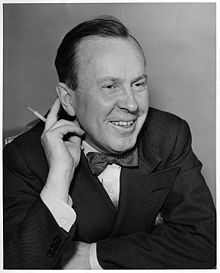
Lester Pearson, Chancellor, Prime Minister, Nobel Laureate
Presidents
- 1942-1947 Henry Marshall Tory
- 1947-1955 Murdoch Maxwell MacOdrum
- 1955-1956 James Alexander Gibson (pro tempore)
- 1956-1958 Claude Bissell
- 1958-1972 Davidson Dunton
- 1972-1978 Michael Kelway Oliver
- 1979 James Downey (pro tempore) 1 January - 15 May
- 1979-1989 William Edwin Beckel
- 1989-1996 Robin Hugh Farquhar
- 1996-2005 Richard J. Van Loon
- 2005-2006 David W. Atkinson
- 2006-2008 Samy Mahmoud (pro tempore), from 20 November 2006
- 2008–present Roseann Runte
知名校友与教职
|
|
It has been suggested that this section be split into a new article. (Discuss) |
Main article: List of Carleton University people
- Nahlah Ayed, reporter for Canadian Broadcasting Corporation
- Jag Mohan, Consulting Engineer & Dean of Engineering Technology and Applied Science, Centennial College, Toronto, Canada
- Dan Aykroyd, Actor and Comedian; studied criminology and sociology, but did not graduate.
- David Azrieli, Architect, 10th richest man in Canada
- Omar Zakhilwal, former Professor of Economics, Afghan Finance Minister and Chief Economic Advisor to the President of Afghanistan.
- Conrad Black, former businessman
- Lindsay Blackett, first black Cabinet minister in Alberta
- Taz Boga, Anchor/Reporter(A-Channel Ottawa)
- Keith Boag, chief political correspondent for Canadian Broadcasting Corporation
- Patrick Boyer, Member of Parliament
- K-OS (Kheaven Brereton), Canadian musician
- Gord Brown, Member of Parliament
- Louise Charron, Puisne Justice of the Supreme Court of Canada
- Rita Celli, host for Canadian Broadcasting Corporation
- Mike Colle, Member of Provincial Parliament
- Alex Cullen, Member of Provincial Parliament, Ottawa City Councillor
- Hans Daigeler, Member of Provincial Parliament
- Barry Devolin, Member of Parliament
- Paul Dewar, Member of Parliament
- Michelle Douglas, Human Rights Activist
- James Duthie, TSN host and Journalist
- Bruck Easton, former president of the Progressive Conservative Party of Canada
- Ward P.D. Elcock, Deputy Minister of Defence, former Director of Canadian Security Intelligence Service
- David Estok, Editor-in-Chief of Hamilton Spectator
- Ivan Fellegi, Former Chief Statistician of Canada
- Matthew Fraser, Editor-in-Chief of National Post
- Evelyn Gigantes, Member of Provincial Parliament
- Edward Greenspon, Editor-in-Chief of The Globe and Mail
- Allan Gregg, pollster, political pundit
- Peter Grünberg, Nobel laureates in Physics 2007
- Elizabeth Hanna, undergraduate major in philosophy and later graduate of the National Theatre School of Canada. Voice Actor and Speech-Language Patholologist.
- Gregory Henriquez, Architect, Governor-General's Medal for Architecture
- Abdul Rahman Jabarah, alleged al-Qaeda member killed in 2003
- Peter Jennings, journalist and news anchor for ABC News, two-time Peabody Award winner, awarded a Litterarum doctor, honoris causa',' in 1997
- Pauline Jewett, Member of Parliament, professor and Chancellor of Carleton University
- Leo Jordan, Member of Provincial Parliament
- Jim Judd, Director of the Canadian Security Intelligence Service
- Wilbert Keon, Senator, heart surgeon
- Warren Kinsella, lawyer, author, musician, political consultant, lobbyist and commentator
- Lawrence M. Krauss, physics professor at Arizona State University and popular science author
- Michael I. Krauss, professor at George Mason University School of Law
- Chalmers Jack Mackenzie, former chancellor, first president of Atomic Energy of Canada Limited
- Robert MacNeil, journalist, Officer of the Order of Canada
- John Manley, Former Deputy Prime Minister and Finance Minister of Canada
- Randal Marlin, Carleton philosophy professor specializing in the study of propaganda
- Robert Maxwell, (BJ '91) Anchor KTVX-ABC Salt Lake City, Utah (also WFTV-ABC, Orlando, FL and The NewRO, Ottawa)
- J.Gordon McNulty, Los Angeles, CA Superior Court Judge
- Yasir Naqvi, Member of Provincial Parliament
- Ryan North, Writer and Computer Scientist
- Tom Nevakshonoff, Member of the Legislative Assembly of Manitoba
- Paul Okalik, Former premier of Nunavut
- Gordon Pape, financial self-help writer
- Ernie Parsons, Member of Provincial Parliament
- Lester Bowles Pearson, former chancellor, professor, Prime Minister of Canada, Nobel Peace Prize laureate
- Gordon Phaneuf, President, Ontario Liberal Party
- John Porter, former Professor of Sociology
- Michael Prue, Member of Provincial Parliament
- Karim Rashid, Industrial Designer
- Scott Reid, Member of Parliament
- Omar Abdirashid Ali Sharmarke, Prime Minister of Somalia
- Norman Sterling, Member of Provincial Parliament
- Barbara Sullivan, Member of Provincial Parliament
- Michael Taylor (1951–2010), former Executive Vice 校长, Atomic Energy of Canada Limited
- Judy Wasylycia-Leis, Member of Parliament
- Jim Watson, Member of Provincial Parliament, former Mayor and City Councillor of Ottawa
- Keenan Wellar, Sociopreneur and Founder of LiveWorkPlay and Heartwood House charities
- Susan Wood, Canadian literature scholar and pioneer of feminist science fiction studies
- Peter Worthington, Editor-in-Chief of the Toronto Sun
- Sara Gruen, fiction author known best for her award winning novel Water for Elephants
[edit] Notable honorary degree recipients
- Dag Hammarskjöld, United Nations Secretary-General (1953–1961), Nobel Peace Prize laureate, awarded a Legum Doctor, honoris causa in 1954
- U Thant, United Nations Secretary-General (1961–1971), awarded a Legum Doctor, honoris causa in 1962
- Kurt Waldheim, United Nations Secretary-General (1972–1981), awarded a Legum Doctor, honoris causa in 1972
- Tommy Douglas, 7th Premier of Saskatchewan, led the first socialist government in North America and introduced universal public health care to Canada, awarded a Legum Doctor, honoris causa in 1980
- Javier Pérez de Cuéllar, United Nations Secretary-General (1982–1992), awarded a Legum Doctor, honoris causa in 1985
- Mikhail Gorbachev, General Secretary of the Communist Party of the Soviet Union, awarded a Legum Doctor, honoris causa in 1993
- Boutros Boutros-Ghali, United Nations Secretary-General (1992–1997), awarded a Legum Doctor, honoris causa in 1995
- Romano Prodi, 79th Prime Minister of Italy, awarded a Legum Doctor, honoris causa in 2001
- Kofi Annan, United Nations Secretary-General (1997–2007), Nobel Peace Prize laureate, awarded a Legum Doctor, honoris causa in 2004
更多
 |
Ottawa portal |
- Carleton Ravens
- The College of the Humanities
- Carleton University Students' Association
- The Charlatan, Student Newspaper
- List of Carleton University people
- CKCU-FM Radio Carleton
- Carleton O-Train Station
- Carleton School of Journalism
- List of Ontario Universities
- List of colleges and universities named after people
- Ontario Student Assistance Program
- Higher education in Ontario
- Canadian Interuniversity Sport
- Canadian government scientific research organizations
- Canadian university scientific research organizations
- Canadian industrial research and development organizations
- International Policy Forum
Notes
- ^ Tam, Pauline (January 8, 2008). Carleton taps woman to lead university. The Ottawa Citizen.
- ^ "Quick Facts | About Carleton". http://www2.carleton.ca/about/quick-facts/#students-november-1-2008. Retrieved September 1, 2009.
- ^ The Right Honourable Herb Gray, P.C., C.C., Q.C. Named Carleton University Chancellor
- ^ http://www.carleton.ca/duc/newsroom/newsreleases/Nov_20_B.htm
- ^ Carleton University
- ^ Excellence Accessibility Responsibility > Ministry of Education
- ^ University
- ^ www.carleton.ca/secretariat/act/index.html Carleton University Act (1957)
- ^ Fast facts about Carleton University and Convocation: - November-Convocation 2005 - Carleton NOW
- ^ Architectural Education
- ^ Carleton tops Harvard for foreign relations MA
- ^ http://www.carleton.ca/duc/newsroom/newsreleases/Sept_15b.html
- ^ Undergraduate Programs
- ^ http://www2.carleton.ca/engineering-design/about-the-faculty/departments-and-schools/
- ^ Canadian Engineering Memorial Foundation - University List
- ^ Carleton University Department of Systems and Computer Engineering
- ^ Carleton University Department of Mechanical and Aerospace Engineering
- ^ http://www2.carleton.ca/engineering-design/about-the-faculty/faculty-history/
- ^ Best projects chosen in 2009 Lab of the Year competition
- ^ University Presses
- ^ http://qnc.queensu.ca/story_loader.php?id=3cd4c2811b9c5
- ^ Innovation in Canada: Innovation Performance—Central Eastern Ontario
- ^ Top 500 World Universities (301-400)
- ^ http://www.topuniversities.com/university_rankings/results/2008/overall_rankings/fullrankings/
- ^ eearank97.dvi
- ^ Gourman Report Ranking of Canadian Universities
- ^ [1] History of Carleton 1979-1990: Coming to terms with a different world
- ^ http://oirp.carleton.ca/pi-2006/tables/hs-grades-update_hpr.htm>
- ^ Symons, Courney (2006-10-05). "Admin to rethink scholarship policy". The Charlatan. http://www.charlatan.ca/index.php?option=com_content&task=view&id=17742&Itemid=26.
- ^ Sock 'n' Buskin Theatre Company
- ^ Parkes, Sara (2005-08-25). "BACKGROUND: Unicentre renovation dispute". The Charlatan. http://www.charlatan.ca/index.php?option=com_content&task=view&id=16207&Itemid=26.
- ^ http://www.accc.ca/english/services/cdnforces/hero.htm Project Hero
- ^ See Dan Aykroyd.
- ^ >
参考文献
- Blair Neatby 'Creating Carleton: The Shaping of a University' (Montreal: McGill-Queen's University Press, October 1, 2002)
- Paul Axelrod 'Scholars and Dollars: Politics, Economics, and the Universities of Ontario 1945-1980' (Toronto: University of Toronto Press, September 1, 1982)
- Roger J. Mesley 'Art Carleton: Carleton University Art Collection' (Ottawa: Carleton University Press)
External links
 |
Wikimedia Commons has media related to: Carleton University |
- Carleton University
- Carleton University Art Gallery
- Carleton University Alumni Association
- Carleton University Library
- Carleton University Students' Association
- Carleton Student Government CSG
- The Charlatan
- Canadian encyclopedia article
- Carleton University Library
- Carleton University Library (catalogue-web)
|
|



